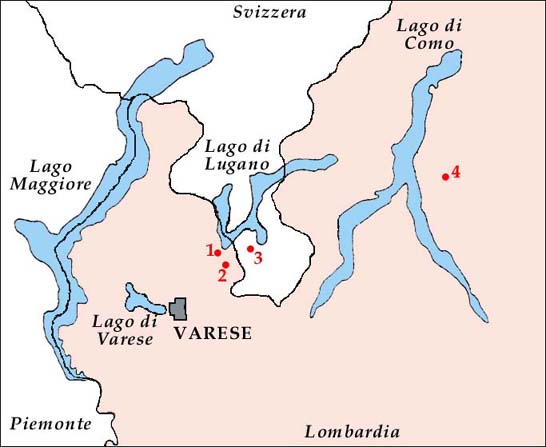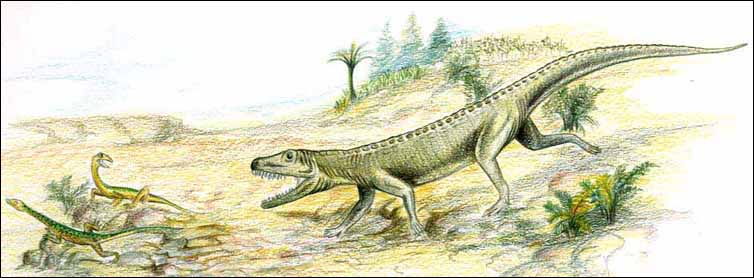
Ladinian fossiliferous localities
(Text and maps in this section are courtesy of the vertpaleo people of Milano University: Prof. Andrea Tintori, Dr. Cristina Lombardo and Dr. Emanuele Gozzi, thanks folks! )

Ladinian localities
1. Besano-M.S.Giorgio
2. Ca' del Frate
3. Meride
4. Perledo
Besano Monte San Giorgio
The Formazione di Besano (in the past also called Scisti Ittiolitici di Besano or Grenzbitumenzone) crops out in a narrow area across the boundary between Italy and Canton Ticino (Switzerland) near Varese: it is the most famous among these fossiliferous units and also the one which has yielded the greatest amount of specimens. Several nice fossils were found in the Italian outcrops, in the last century, during paleontological researches as well as during the industrial exploitation of biniminous schists (up to 40% total organic carbon, TOC). Unfortunately, all this material was completely destroyed when the Museo Civico di Storia Nanirale di Milano was bombed during the Second World War. At the beginning of this century, digging was started also in Switzerland, near Serpiano. The aim was the aim industrial exploitation of bitumen, at first as a source of energy, then for the production of "Saurol", an oily compound used for skin deseases. The activity ceased soon after the end of the Second World War, but paleontological researches, started in the 1920s on the Swiss side, continued until the 1970s, to be then started again on the Italian side by the Museo Civico di Storia Nanirale di Milano. All authors have always considered the depositional environment as strictly anoxic; but no one of them has ever considered vertebrate taphonomy. Sander recognized a certain alteration in the bones distribution, but he drew no conclusions from this observation. The main fossiliferous level consists of laminated, grey-hazel-brown dolomites, quite regularly alternated to black oil-shales, which are the reachest in organic carbon. Other three similar, but thinner, levels are present in the Calcare di Meride. Fossils are found in both the lithotypes, and the kind of preservation is also very similar. From a taphonomic point of view, it implies that during deposition the boom environment must have been almost constant. Thousands of specimens have been collected by Swiss team from Zurich: more than 30 fish and 15 reptile genera are represented. Though many of them are found wholly articulate, several show unimodal dispersal of skull bones and distal fin elements. Dispersal is mostly antero-posterior in small fishes: skull bones lie along or around the body, while distal segments of lepidotrichia are scattered behind the fins themselves. As regards reptiles, these are usually larger than fishes and the eventual bones scattering, though still unimodal, is transversal to the body. The examination of fossils distribution on a layer surface ,though not really corresponding to the field situation reveals that small fishes are parallely arranged, with most skulls in the same direction. This is an evidence of bottom currents, further proved by the antero-posterior dispersal of bones. Currents at the bottom of a shallow basin imply a partial and/or temporary mixing of waters, bringing oxygen to the bottom itself. Therefore, at least a disaerobic environment can take place, allowing a faster decomposition of vertebrate soft parts and then a mainly unimodal dispersal of bones by the current. Because these conditions probably had a seasonal character (probable monsoonic climate), after the currents ceased all the oxygen on the bottom was consumed, and a new anoxic environment established. Thin, pyritic patinas on reptiles and fish bones suggest a rapid burial in organicrich, sulfidic muds; the micro-environment around the organism is strongly, different from the adjacent sediment, poorer in organic matter. Fossils pyritization mainly occurs in "minimally aerobic environment, and not in an anaerobic one. Since this process apparently takes place at or just below the sediment/water interface, it would support the idea that bottom waters were not totally anaerobic. We can conclude that vertebrate biostratinomy certainly points to the presence (though in minimal amounts) of oxygen at the bottom (disaerobic environment). These conditions, depending on currents action, possibly had seasonal character, alternating to a strictly anaerobic environment. It follows that the very high TOC of the unit is not only the result of the bottom environment; to explain it, we must also hypothesize a very high organic input, provided by the sea as well as the surrounding lands.

The rauisuchid Ticinosuchus runs after two Macrocnemus near the shore at Besano
Ca' del Frate (Varese, Italy)
The locality of Ca' del Frate, near Besano (Varese), has been known since the beginning of this century but only recently it has yielded a considerable amount of specimens. Its fauna consists of about 10 fish genera, one reptile (Lariosaurus) and a couple of crustacean genera; it is very little differentiated, suggesting a hostile environment. The succession is apparently characterized by intervals with alternatively normal and very low salinity. Fossiliferous levels consist of very finely laminated, more or less marly limestones, with a varvate aspect. Light, thick, carbonatic laminae alternate to dark, thin ones, richer in clay and organic matter. The seasonal character of deposition has been proposed by Tintori on the basis of the different average size of Prohalecites found in the two lithologies. The TOC is altogether low: not even the levels with the highest clay and organic matter content can be considered as bituminous. Vertebrate taphonomy is well represented in Prohalecites: this small fish (max 45 mm) is always found perfectly articulate and randomly oriented. The same can be said of the other vertebrate specimens as well as of crustaceans; these latter are often found with soft body and eggs preserved. Sometimes great amounts of these organisms lie on a layer surface, testifying the possibility of mass mortality. This unit was probably deposited in a shallow basin with a totally anoxic bottom. The anoxia would be due to water stratification, originated by high freshwater input after abundant rains, which could also explain mass-mortality events. An alternative hypothesis could be the formation, in extreme conditions, of microbic films, isolating the dead organism on the bottom. The preservation of vertebrates in this unit is thus very good, in spite of a low TOC. Thus, the organic matter was preserved only because of peculiar bottom conditions and not of overproduction. On the other hand, the shallow basin, with its low productivity and wide salinity oscillations, was not favourable to large biomasses.
further information at http://users.unimi.it/vertpal/index.htm
Artwork by S. Renesto unless otherwise indicated. Please do not reproduce/repost/republish etc. any text or image without asking permission to the author
Home Research Triassic Reptiles